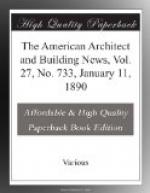These several topics will be considered in reference to the reduction of the fire-loss on isolated manufacturing property, because the exercise of every possible precaution may not avail anything if the property is liable to be imperilled by fires originating in adjacent buildings.
SUPERVISION.
The prevention of fires must in greater measure proceed from the efficiency of the supervision exercised over the property in the order of the buildings, heed to probable causes of fire, and attention to the fire-apparatus.
In a manufactory there is a wide distinction to be made between to-day’s dirt and yesterday’s dirt; valuable results may be obtained by an inspection of the whole property made on Saturday afternoon by two men, such as foremen or overseers of rooms, who may be appointed to serve four weeks, their assignment terminating on alternate fortnights. The report should be made on a sheet of paper, divided so as to include all features of order and fire-apparatus in every room.
As property should be watched during the day Sunday, as well as at night, it is under the care of watchmen about five-eighths of the time, and the measure of this responsibility should be clearly understood.
The patrol should be recorded on a watchman’s clock, not merely to show that he was not unfaithful, but also to prove that he was faithful.
Especially in districts liable to disorder and lawlessness, it is desirable to have a district-messenger signal-box in the works, visited once an hour, with the understanding that if the call is not made within fifteen minutes of the appointed time, it will be assumed that there is trouble and help sent at once.
Safety requires that the lanterns should be securely guarded; that the handle and sustaining parts of the lantern be connected together by rivets or by locking the metals together without relying on soldered joints; and thirdly, that the lamp should be put in from above, and never from the bottom.
CONSTRUCTION.
In its design, a mill for any standard line of manufacture is not a building whose arrangements and proportions are fixed upon at the whim of the owner, but it must conform to certain conditions of dimensions, stability, light and application of power to satisfy the requirements essential for furnishing every advantage necessary for producing the desired results at the lowest cost.
The destructive consequences attending fire in such buildings, whose iron and masonry construction is called fireproof, show that some other form of construction is necessary to obtain the desired results of minimizing the annual cost of the maintenance of the invested capital, as represented by insurance, depreciation, interest and taxation. There is little incentive for entering into unusual expenses in the construction of a manufacturing building for the purpose of increasing




